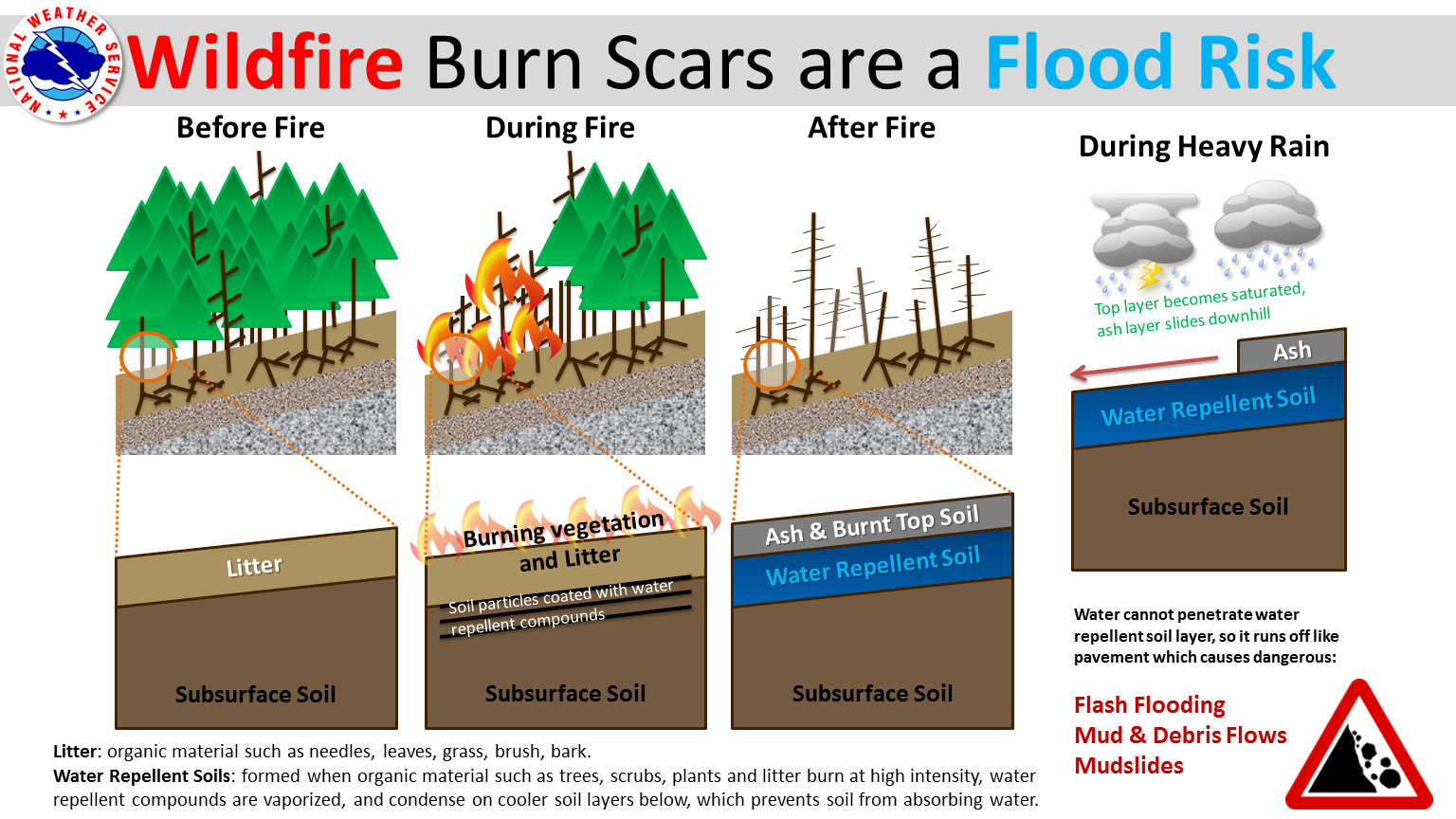
Have you ever heard of a burn scar? Did you know that these remnants of wildfires can cause dangerous flash floods and debris flows? Well, today we’re going to learn all about it.
While this is a topic most relevant to the west, it’s good information for anyone to know that might visit a mountainous region. Wildfires have lasting effects on the landscape, both in the immediate area and for locations several miles away. Areas downhill and downstream from burned land are susceptible to flash flooding and debris flow, especially near steep terrain. Rainfall that would normally be absorbed will run off extremely quickly after a wildfire. This is because burned soil can be as water repellent as pavement. As a result, much less rainfall is required to produce a flash flood.
This layer of water-repellent soil is formed when organic matter such as trees, shrubs, and plants burn at high intensity. When this happens, water repellent compounds are vaporized and condense on cooler soil layers below, which prevents soil from absorbing water. This will not only cause flash floods, but debris flows. As water runs downhill through burned areas, it can create major erosion and pick up large amounts of ash, sand, silt, rocks, and burned vegetation.
The force of the rushing water and debris can damage or destroy culverts, bridges, roadways, and buildings even miles away from the burned area. The time required for a flash flood to begin depends on how severe the fire was, how steep the terrain is, and the precipitation rate. A good rule of thumb is that half an inch of rainfall in less than an hour is sufficient to cause flash flooding in a burn area, but it depends on all the previously mentioned factors. Light precipitation on steep terrain that was severely burned can cause flash flooding within minutes!
If you are in an area vulnerable to flooding and debris flows, plan in advance and move away from the area. There may be very little time to react once the storms and rain start. A good rule of thumb is: “If you can look uphill from where you are and see a burnt-out area, you are at risk.”
Wild fires are a natural part of the ecosystem. The forests need them to stay healthy. Let’s start at the baseline of what naturally occurs without human intervention and go from there. Right now we are suffering from 100 years of humans unnaturally trying to put them out. We have overgrown forests throughout our country. Let’s focus on returning them to a more natural state.
Yup, except a lot longer than 100 years of fire fighting although few years of the concentrated attack. One issue is that to get back to the natural state, the forests need to be cleared of the undergrowth that the regular fires used to keep in check. The options are to hire the clearing or to do winter burning, either option requires manpower. At the onset of the Rim Fire near Yosemite several years back there was a report of a forest survey by UC Berkeley that proclaimed that the undergrowth in the area needed to be reduced to mitigate the danger of a wildfire. That report was from the 19teens. The funding requests were consistently refused by the Feds, basically because they did not accept that a threat existed. For ~100 years the area was neglected and the result was devastating. Similar fires ravaged Yellowstone and other areas following the Fed policy of letting them burn while focusing efforts on structure/asset protection–a plan that will eventually be in line with your comment but the unmitigated undergrowth resulted in devastation that is in no way ‘natural’.
It costs mega bucks to accomplish that using human-engineered removal…although I have seen hundreds of acres of private land cleared near my home in the Sierra foothills. The state makes funds available to private parties (almost exclusively large land owners).
California is at the mercy of the federal government for the BLM, National Forest, and other US land in the state–the Feds own 58% of the forest lands–despite what is stated in all the propaganda. The state has pretty much managed their 3% share of forest land in the state. The grant programs are helping with the large private owners (who account for the remaining 39%), primarily timber companies, plus those folks are somewhat proactive since the lands are their moneymakers. I have cleared the undergrowth for several hundred feet around my house in the hope that, at a minimum, any fire coming through will be very low energy in this area and, ideally, the fire crews will build on my fire break and clear the neighbors untended brush.